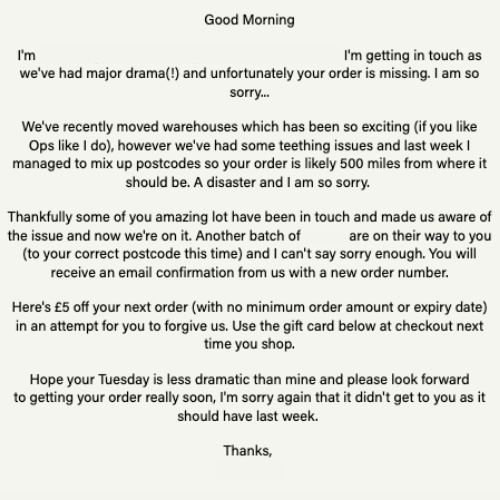A guide for DTC brands: How to draft the perfect apology email
We all make mistakes. We're all human. And after all, DTC brands are ran by... Humans.
Within our It's Personal team, we have decades of experiences working brand-side for DTC brands, so we know all-too-well how it feels to mess up, and frantically try to fix it.
Now, working agency side, we work with our lovely clients to draft meaningful and personalised CRM solutions if something goes wrong, and they need to apologise to their customers.
Whether it's a product hiccup, shipping delays or a communication misstep, addressing mistakes with transparency and authenticity is pivotal for maintaining customer trust.
And when it comes to apologising to your customers, the ideal channel is undoubtedly email marketing!
Here's a comprehensive guide on what steps to follow to draft that perfect 'we're sorry!' email...
1) Act fast
The first step in correcting any error is prompt acknowledgment. Confront the issue directly in a clear and concise manner. In your apology email, admit the mistake, explain the misstep and reassure customers that you're actively resolving the issue.
2) Personalise!
Tailor your apology to resonate with your audience. Employ a conversational tone and, if appropriate, infuse some brand personality. A personalised apology humanises your brand, conveying to customers that you empathise with their concerns and, ultimately, that you're human too!
3) Provide solutions and compensations
Offer practical solutions to alleviate the impact of the mistake. This may involve refunds, discounts on future purchases or expedited shipping for affected orders. Demonstrating commitment to rectifying the error reinforces your dedication to customer satisfaction.
4) Be engaging
Ensure the right people open your email by crafting a subject line that is both sincere and attention-grabbing. For instance, "We Messed Up, Here's How We're Fixing It."
5) Segment
If the mistake affected specific segments of your customer base, segment your email list accordingly. This ensures your apology is seen by the right audience and minimises potential backlash from unaffected customers.
6) Be transparent
Clearly outline the steps you're taking to rectify the mistake. Whether it's improving quality control, optimising logistics or enhancing communication channels, transparency instills confidence in customers that you're actively working to prevent similar issues in the future.
7) Encourage feedback
Invite customers to share thoughts and concerns in response to the apology. This not only fosters a sense of community but also provides valuable insights to enhance your processes and prevent future mistakes.
8) Follow up!
A sincere apology is just the beginning. Follow up with affected customers to ensure the solution was satisfactory and gather feedback on their experience. This ongoing communication rebuilds trust and showcases your commitment to customer satisfaction.
9) Learn from your mistakes
Conduct an internal review to understand the root cause of the mistake. Use this insight to implement preventive measures and communicate these improvements to customers, demonstrating your commitment to continuous enhancement.
Implementing these steps allows DTC brands to transform mistakes into opportunities to strengthen customer relationships and build trust in the long run.
Remember, transparency, sincerity and proactive communication are essential in the art of effective apology.
And remember, don't beat yourself up - we're all humans, after all!
To finish, we wanted to share a fantastic example of a “we messed up, and we’re sorry!'“ email that we’ve seen recently… This brand have absolutely nailed it.


